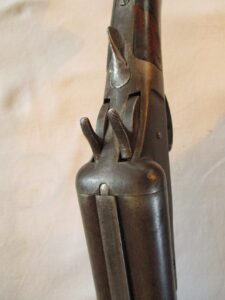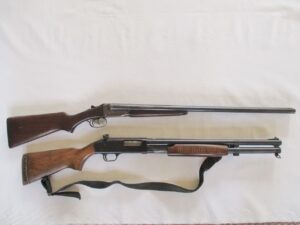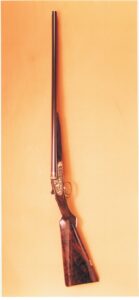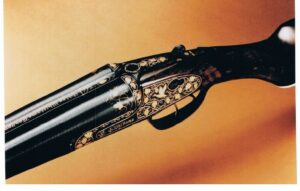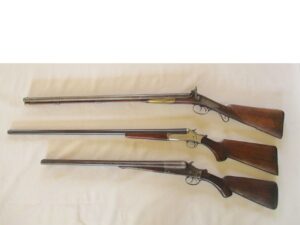
12-gauge hammer shotguns top to bottom: Hollis percussion cap muzzleloader, Nitro Hunter single barrel and Nitro Hunter double barrel.
By Jim Dickson | Contributing Editor
When we think of shotguns you find plenty of articles about the highest grade Parker shotguns and its rivals but only a tiny fraction of the hunters out there then or now ever hunted with such a gun.
The average farmer or working man wanted an inexpensive, reliable game getter and price was very much a determining factor in what he could afford to buy. Just look at the old turn of the century gun catalogs from Sears Roebuck and others and while you will find examples of higher priced shotguns the great bulk of the selection is devoted to more affordable guns.
The most popular was the classic single barrel shotgun. Cheap and reliable it was light and lively in the hands and deadly on game. Many of its early users had started out with single barrel muzzle loading shotguns and a breech loading single barrel was a logical modernization.
These light guns are among the liveliest and responsive factory shotguns available. They served so well that many men never wanted anything else. It became almost a standard piece of farm equipment throughout the country and was often found in the horse drawn farm wagons of the day just as guns are often in a pickup truck’s gun rack today.
Many farmers carried these light guns as they went around tending their farms in order to be able to shoot any predators attacking their livestock. Back then that included chicken hawks and two legged chicken thieves as well. The prosperity of the 1950s was still far in the future but a working man with a family to support could still come up with the money for a single barrel shotgun that would not let him down in the hunt.
These guns needed no safety. Just leave the hammer down until you were ready to fire. They cocked as easily as a Colt Single Action Army revolver as they were being raised to fire.
The extremely light weight of these guns helped popularize a load of 1 ounce of # 6 shot over 3 drams of powder in a 12-gauge shell. This load was the most popular load for many decades. It has little recoil and the small shot charge patterns better than heavier shot loads. It is patterns that matter when you are hunting. The # 6 shot proved the best all round size for anything you shoot with birdshot. All this is critical on a Southern dove hunt where you can easily fire as many or more shots in one day than on a Scottish driven grouse shoot. This is the only birdshot load I ever use in a shotgun. It works that good.
Single barrel shotguns are still made today but they tend to have coil springs that have a mushy feel when you cock the hammer instead of the positive firm feel of the leaf springs in the older guns and many lack the traditional top lever for opening the action.
The lure of a fast second shot is always there and nothing delivers it better than a double gun. There were many boxlock and even sidelock shotguns at reasonable prices. A unique piece was the Nitro Hunter double made like two single barrel shotguns in one receiver with the hammers sticking up out of the middle of the action. Nitro Hunter with its ram’s skull trademark was the store brand of Belknap Hardware company who bought the guns from Folsom Arms company among others. Many years ago I put countless rounds through a well-worn example of this unusual type of double. Nitro Hunter shotguns always handled better for me than any other factory shotgun.
Many of the earlier doubles were hammer guns and it took a while for the modern hammerless double to gain widespread acceptance. People were leery of a cocked gun and distrustful of the mechanical safety. Hammers down was the accepted safe carry method of the day. Never mind the fact that the hammers could be fanned back to full cock by hanging up on brush without you realizing it.
The hammer doubles enjoyed great success. In England King George V said “A gun without hammers is like a spaniel without ears.” England’s greatest Victorian era game shot, the 2nd Marquis of Ripon, bagged 316,000 birds from 1867-1895 shooting most of them with his set of 3 Purdey hammer doubles.
Aside from the classic looks of the hammer gun which traced back to the muzzleloading era many men enjoy the feel and sound of cocking the hammers and their impact on the firing pins. There were plenty of stout economy grade hammer doubles available to satisfy them.
Many of the early economy grade guns sported Damascus barrels. Contrary to popular belief there is no such thing as cheap Damascus barrels. The Damascus barrel makers were careful that no inferior quality barrels were ever sold. After the introduction of smokeless powder all these Damascus barrels were intended to be used with smokeless powder shells. Those made before that time had no difficulty shooting smokeless powder either.
An early Damascus barrel breech loading John Dickson and Son shotgun from 1858 recently was sent to the British proof house for reproofing for smokeless powder. It passed with flying colors as did an early Purdey muzzleloader which had been converted to a breechloader about that time. Destruction tests at the British proof houses show that the best Damascus barrels are 3 points stronger than the best fluid steel barrels. They keep careful records at the English and continental proof houses and the results are enlightening. No Damascus barrel in proof, meaning not rusted out, reamed out thin by polishing, severely dented, etc. has ever failed with the loads it was proofed for. That is not true for even the most modern fluid steel barrels. I have personally known two men whose hands were mangled by fluid steel barrels bursting with factory loads. This occurs when a slag inclusion or an air bubble in the steel goes through the rolling mill and comes out elongated as a seam. The stress of repeated firing makes a crack appear at this point and it deepens until the barrel fails. With a Damascus barrel the crack permanently stops at the next lamination layer.
One of the most popular doubles was the Stevens Model 311 which was made from 1877 to 1988 with estimates of total production reaching as high as 5 million guns. A solid well handling shotgun it has filled the game bag for countless hunters from its inception down to the present day. Incredibly there are few written records about this milestone in American shotgun production and it looks like it is too late to tell its story in detail. Parker and L.C. Smith may get all the magazine space but they can’t compare their game bags to those of the lowly Stevens 311. It was a case of offering the most gun for the least amount of money and the tough, dependable 311 just kept going out of the stores in the customer’s arms.
Pump shotguns offered a 5 round magazine capacity but game laws soon required a plug to restrict this to 3 shots. The Winchester M1897 got America pumping shotguns in the days before the plug requirements and soon hammerless pump shotguns were on the market. Guns like the Winchester Model 12 and Ithaca Model 37 were soon making their mark although the pump gun was not necessarily a budget gun. For the budget minded today the Mossberg Model 500 offers the most bang for the buck and fits into the economy category of shotguns better than the previously mentioned pump shotguns.
It is a grave mistake to look down on the economy shotguns. They are all many people could afford and without them we would have far less shooters. The men using them often depended heavily on them and became quite expert in their use. They provided food and fun for countless millions and can rightfully be termed the shotgun for every man because of the preponderance of their numbers. All those satisfied proud users can’t be wrong.

